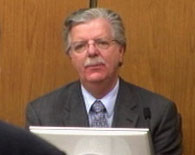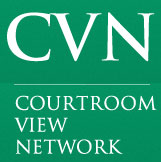Listman vs. OMC trial 16 November Session 2b
This post is part of our coverage of the Listman v. OMC propeller injury trial
Robin Listman vs. Outboard Marine Corporation
Second Judicial District Court of the State of Nevada, County of Washoe
16 November 2011 Session Two continued
Our coverage was obtained via a video feed supplied by Courtroom View Network (CVN). The images are also courtesy of CVN.
This session focused on testing of the proposed / exemplar guard.
Testimony was heard from:
- Robert Taylor – an expert witness for the defense
We heard from two attorneys:
- Jay O’Sullivan for OMC
- Robert Frank Vaage (Robert Vaage) for Listman
Robert Taylor
Jay O’Sullivan for OMC questioning Robert Tayor, his expert witness.O’Sullivan developed Robert Taylor’s experience and credentials.
Taylor is a Naval Architect and an Engineer working for Design Research Engineering (DRE) in a Detroit suburb.
DRE is an engineering consulting firm with 31 employees. They work on accident reconstruction, failure analysis, and risk analysis.
His part of the business is maritime, the other half is automotive.
He does some straight forward research, mostly accident prevention. Taylor has been requested to do research for the U.S. Coast Guard.
In the 1980’s Taylor worked for a larger firm.
DRE (where he now is) has 17 degreed engineers, several lab technicians, a video guy, and a support staff.
Half of the building is offices, the back half is an area they can setup to do experiments for clients.
Even this early, it is very obvious that Robert Taylor is extremely smooth. He exhibits confidence, has a nice voice, and explains thing at a perfect pace.
Taylor said, I am one of the few Naval Architects that can do field testing of boats in a very measurable way.
Taylor said that one of the things he brought to the industry was the use of a GPS base station to get very good accuracy.
He said that accuracy is plus or minus 1/4 inch in three dimensions per the specifications, but he thinks it is more in the range of plus or minus 1/2 inch.
Back when he started years ago, they just looked back at their path in the water to see where the boat had been.
If you are using a GPS in a boat without a base station, the accuracy is considerably worse. Often there are dropouts and you may see the boat going backwards. It could be 5, 10 or 20 feet.
He explained roll, pitch, and yaw (he called yaw surge at first) and why it is important to know where you are at in all 6 degrees.
Taylor said he wished he had brought a toy boat, then used his hands to explain roll, pitch, and yaw. He is so smooth it looks like he belongs on the Discovery Channel.
As I write this, I feel awkard replying to him by his last name only in order to save space. I had no such similar feelings about the other witnesses. I subconsciously want to address him as Dr. Taylor even though he does not have a PhD. Taylor has a bit of a grandfathery look to him and all I can say is he is very smooth.In addition, his boating industry clients have paid him a lot of money through the years that have allowed him to purchase some very nice instrumentation that is far beyond the reach of most boat litigation engineering firms.
When asked how he became involved in this specific litigation, Taylor said he was contacted by O’Sullivan, looked at some of the early documents, learned a little about the case, and he and O’Sullivan had worked together in the past.
Taylor was asked to review the facts of the circumstances, evaluate the design and performance of the boat in stock condition with no guard, and with the guard. He and his company tested both guards (prototype 1 and prototype 2) on multiple occasions.
As is his custom, Taylor asked for the discovery documents, reviewed them, he always asks if the evidence is still available and was able to inspect the boat, they purchased an identical boat (built same month and year), tested the exemplar boat in stock condition, tested the exemplar boat with prototype 1 guard in instrumented and uninstrumented fashion, tested maneuverability and made plots of data and compared them.
The maneuverability data was recorded in all six dimensions, steer and throttle position were recorded, recorded video forward, recorded video of operator, recorded video from shore, and all data was time synched.
He has a degree from University of Michigan in 1972 and a Masters of Science in Engineering from Berkley.
Taylor has 30 years of experience.
1972-80 worked at Naval Ship Engineering Center
1980-96 worked at Failure Analysis
1996-present at a firm he and three others split off from Failure Analysis and formed, DRE.
O’Sullivan went on to reveal more of Taylor’s experience and his involvement in some major investigations.
Finally a plaintiff attorney said, “all very interesting but can we get somewhere?”
O’Sullivan said something about moving on now, but he continued to develop more of Taylor’s experience.
Robert Taylor is as close to as perfect fit of an expert witness in this field as they defense could find to work for them. He comes across as very knowledgeable and experienced, is very likeable, has an unbelievable amount of instrumentation at his beck and call plus about thirty more folks if they need them, and seems to be gently leading along the jury explaining complex things to them in simple ways. Plus he has a near perfect presence on the stand and great voice. I am really singing his praises because that is how good he is for them.
However, things may not be so Kumbaya when the plaintiff’s lawyers get a shot at him later.
Taylor’s November 16th testimony is continued on November 16 Session 2c

